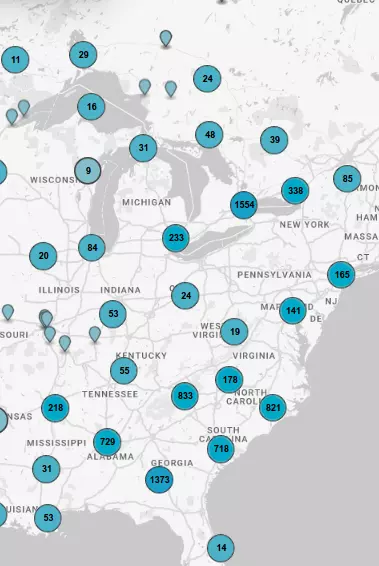Historic Dugas Home
This home was built by Mr. and Mrs. Louis Dugas, French refugees from Santo Domingo, in the early 1790s. Here, until 1810, Mrs. Dugas conducted the Boarding School For Select Young Ladies which...
- lat34
First Methodist Church
Organized in 1819, this Church is an outgrowth of Grant´s Meeting House, the first Methodist Church building in Georgia, erected 5 miles E, in 1787. In 1820, the Methodists built the first...
- lat34
Washington Presbyterian Church
The Presbyterian Church of Washington was organized in1790, under the Presbytery of South Carolina with the Rev. John Springer as the first pastor. Services were held in private homes, in the...
- lat34
Phillips Mills Baptist Church
On June 10th, 1785, 18 members met in a mill on this site owned by Joel Phillips, a Revolutionary soldier, and organized Phillips Mill Baptist Church. The Rev. Silas Mercer, leader of the group,...
- lat34
Kettle Creek Battleground
One and one-half miles North and half mile West is War Hill, site of the Battle of Kettle Creek, one of the decisive Battles of the Revolutionary war. It was at Kettle Creek, on February 14, 1779,...
- lat34
Grant's Meeting House
On this site the first Methodist church building in Georgia was erected in 1787. Daniel grant and his son, Thomas, prosperous merchants of this area, were its builders. Bishop Asbury often visited...
- lat34
Fishing Creek Baptist Church
Fishing Creek Baptist Church, the second of this denomination to be constituted in the upcountry of Georgia, was organized in 1782, under the leadership of the Rev. Sanders Walker, who became its...
- lat34
Site of Wilkes County Academy
This is the site of Wilkes County Academy, built in 1797, The Academy was authorized by the Legislature in 1783, one of the first public schools charted by the State of Georgia. Commissioners...
- lat34
Walnut Hill Academy
Walnut Hill Academy, one of the famous schools of its time, was established in 1788 by the Rev. John Springer in a building erected close to his house on this plantation. Among the Students taught...
- lat34
The Rev. John Springer
The Rev. John Springer, 1744-1798, distinguished minister and educator, is buried in the garden on this plantation, Walnut Hill. A graduate of Princeton, he taught there and at Hampden-Sydney, and...
- lat34
Gilbert-Alexander House
In the 1780s Felix and William Gilbert, Virginians, camped in a beautiful grove here and were so pleased with the scenery that they returned later to take land grants. In 1808 they erected the...
- lat34
Home of Robert Toombs
This was the home of Robert Toombs - planter, lawyer, and distinguished Southern statesman. Born July 2, 1810. Robert Toombs was educated at Franklin College, Georgia, at Union College, New York,...
- lat34
Washington-Wilkes Historical Museum
This museum shows the splendors of plantation life in Georgia before the War Between the States, displays relics, mementos and keepsakes of the era that tried men`s souls, and adds a fine...
- lat34
Home of Sarah Hillhouse
This Federal style house was begun in 1814, by Sarah Porter Hillhouse who came to Washington in 1786, from Connecticut with her husband David. In 1801, David purchased the town`s first...
- lat34
Old Inn Site
This building stands on the site of one of the most popular inns of the early stagecoach days. Under it are the ancient handhewn timbers, hand made brick and massive beams of the inn basement. In...
- lat34
Campbell Home
This was once the home of two distinguished Georgians - father and son. Duncan G. Campbell was noted for drafting the treaty that removed the Cherokee Indians from Georgia and also for introducing...
- lat34
The Cedars
The high hill on which The Cedars stands was a home - site for the Indians before the arrival of white men. Not long after the Revolutionary War, Anthony Poulin, a Frenchman of noble Birth...
- lat34
Smyrna Churchyard
This burying ground was laid out in 1788 when Sir John Talbot gave two acres of his vast estate for use as a Presbyterian Church and churchyard. Sir John was descended from the Early of...
- lat34
Holly Court
Holly Court Two 1830s Houses Federal Plainstyle 1840s Dr Fielding Ficklen plantation house moved here by oxcart from Ficklen, joined to existing house, portico added. 1864 Mrs Jefferson Davis...
- lat34
1820 Early Classic Revival House
Early Classical Revival house with a full daylight English basement unpainted for 100 years. Constructed of hand planed virgin pine — 1934 Oliver S. Dyson, Founder Wilkes Telephone & Electric Co....
- lat34
